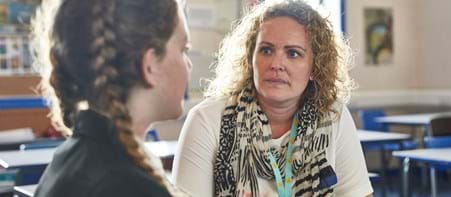Children and young people's mental health statistics
Children and young people's mental health statistics
Every day, children and young people across the UK struggle with their mental health.
We believe that no child should face a mental health problem alone. Our children's mental health statistics show how important it is for children to access the support they need and how we help them in doing so.
On this page, you can find:
- key children's mental health statistics
- mental health statistics for children and young people in poverty
- statistics linking education and children's and young people's mental health.
If you want to learn more about the impact of our mental health support in schools, you can visit our Statistics and evidence page or read our Impact Report.
Key mental health statistics
- 1 in 5 children experience mental health difficulties1.
- Half of mental health issues develop by age 142
- 420,000 children and young people in England are treated for mental health problems every month3.
- Children and young people with mental health difficulties go an average of 10 years between becoming unwell and getting help4.
- Almost a million children and young people accessed mental health services in 2021-225.
- The most common mental health problems among young people are emotional disorders, including anxiety and depression6.
Our impact on children and young people's mental health
Our vision is for all children and young people to have the support they need to build lifelong coping skills and thrive. In the 2022/23 academic year:
- our mental health support services in schools were accessed by 36,565 children and young people
- 78% of children aged 4-11 years old showed an improvement in mental health after having one-to-one counselling with Place2Be
- 91% of children aged 11-18 years old showed an improvement in mental health after having one-to-one counselling with Place2Be
- 9% of children and young people that accessed our services were on Child and Adolescent Mental Health Services (CAMHS) waiting lists.
Children's mental health and poverty
Children and young people from low-income families are four times more likely to experience mental health problems than children from higher-income families8. Out of children and young people with a diagnosable mental health condition1:
- 1 in 4 live in a household that has experienced a reduction in household income
- 1 in 10 live in a household where they had not been able to buy enough food or had to use a food bank
- 14% live in a household that can not afford to keep the house warm enough.
Our impact on children and young people in poverty
As part of the Fair Education Alliance, we believe no child's success should be limited by their socioeconomic background. It's important to us that we reach the children and young people that need us the most. Of the children receiving one-to-one counselling with us7:
- 61% receive free school meals
- 6% have a child protection plan (CPP), meaning social services have deemed them to be at risk of significant harm
- 43% are eligible for Pupil Premium.
Children's mental health and education
There is a strong link between education and mental health9. Compared to those unlikely to have a mental health condition, children and young people with a diagnosable mental health condition were1:
- 45% less likely to feel they can be themselves at school
- 27% less likely to enjoy their learning
- 20% less likely to have at least one friend at school.
Our impact on children's and young people's education
Often, school is the most common source of help for children and young people with mental health concerns. Our mental health support services aim to help children and young people at school when they need it the most.
After receiving one-to-one counselling with Place2Be7:
- 74% of children and young people with a history of school exclusions had fewer exclusions
- 63% of pupils whose difficulties impact their learning in class improved
- 68% find it easier to make and keep friends.
Talk to our team
If you'd like to speak to us about our mental health statistics, feel free to contact press@place2be.org.uk, and our press team will be happy to help.
References
1NHS Digital (2023). Mental Health of Children and Young People in England, 2023 - wave 4 follow up to the 2017 survey.
2Kessler, R. C., Berglund, P., Demler, O., Jin, R., Merikangas, K. R., & Walters, E. E. (2005). Lifetime prevalence and age-of-onset distributions of DSM-IV disorders in the National Comorbidity Survey Replication. Archives of general psychiatry, 62(6), 593–602.
3NHS Digital (2019). Mental Health Services Monthly Statistics - NHS Digital.
4Centre for Mental Health, & Khan, L. (2016). Missed opportunities: A review of recent evidence into children and young people’s mental health.
5NHS Digital. (2021). Mental Health Bulletin, 2021-22 Annual report.
6Clarke, A., Pote, I., Sorgenfrei, M., & Early Intervention Foundation. (2020). Adolescent mental health evidence brief 1: Prevalence of disorders.
7Place2Be. (2022). Impact Report 2022.
8Gutman, L. M., Joshi, H., Parsonage, M., Schoon, I., Centre for Mental Health, & University College London. (2014). Children of the new century: Mental health findings from the Millennium Cohort Study.
9Lereya, S. T., Patel, M., Dos Santos, J. P. G. A., & Deighton, J. (2019). Mental health difficulties, attainment and attendance: a cross-sectional study. European child & adolescent psychiatry, 28(8), 1147–1152.







